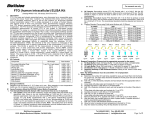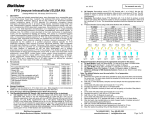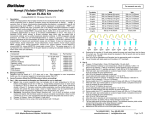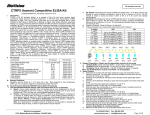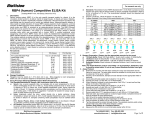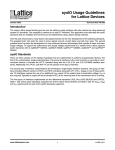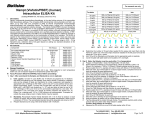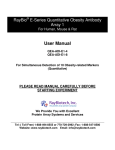Download NQO1 (human intracellular) ELISA Kit
Transcript
BioVision NQO1 (human intracellular) ELISA Kit b) (Catalog #K4926-100; 100 assays; Store kit at 4°C) I. II. Description: NAD(P)H:quinone acceptor oxidoreductase 1 (NQO1), a multifunctional antioxidant enzyme and exceptionally versatile cytoprotector, both protects the cell from carcinogenic oxidative damage and stabilizes the tumor suppressor p53 protein. At high glycolysis levels NQO1 stabilizes and protects p53 from ubiquitin-independent degradation, a process that is NADH dependent, and also elevates NAD+/NADH levels. NAD+ and NADH play a crucial role in cellular energy metabolism, and a dysregulated NAD+/NADH ratio is implicated in metabolic syndrome. In humans, NQO1 is expressed at high levels in adipocytes and its expression levels are positively correlated with adiposity, glucose tolerance, and liver dysfunction. Thus NQO1 may provide the basis for a new therapy for the treatment of metabolic syndrome. This assay is a sandwich Enzyme Linked-Immunosorbent Assay (ELISA) for quantitative determination of human NQO1 in cells. A monoclonal antibody specific for NQO1 has been precoated onto the 96-well microtiter plate. Standards and samples are pipetted into the wells for binding to the coated antibody. After extensive washing to remove unbound compounds, NQO1 is recognized by the addition of a purified polyclonal antibody specific for NQO1 (Detection Antibody). After removal of excess polyclonal antibody, HRP conjugated anti -rabbit IgG (Detector) is added. Following a final washing, peroxidase activity is quantified using the substrate 3,3’,5,5’-tetramethylbenzidine (TMB). The intensity of the color reaction is measured at 450 nm after acidification and is directly proportional to the concentration of NQO1 in the samples. This ELISA is specific for the measurement of natural and recombinant human NQO1. It does not cross-react with human adiponectin, human RBP4, human Nampt, human vaspin, human progranulin, human resistin, human clusterin, human ANGPTL3, human CTRP5, human IL -33, human leptin, human GPX3, human NMNAT2, human sirtuin 1, human FTO, mouse Nampt, rat Nampt. The assay range is 0.313 – 20 ng NQO1/ml and a detection limit of 100 pg/ml (based on adding two standard deviations to the mean value of the (50) zero standards). Kit Contents: Component Pre-coated Microtiter Plate Wash Buffer (10X) Diluent (5X) Lysis Buffer (10X) Detection Antibody Detector 100X (Hrp conjugated anti-IgG) Human NQO1 Standard (lyophilized, 40 ng) Human NQO1 QC Sample (lyophilized) TMB Substrate Solution Stop Solution Plate Sealers For research use only rev. 01/12 100 Assays 1 ea (12 x 8 well strips) 50 ml 50 ml 12 ml 12 ml 150 μl 1 vial 1 vial 12 ml 12 ml 3 each III. Part Number K4926-100-1 K4926-100-2 K4926-100-3 K4926-100-4 K4926-100-5 K4926-100-6 K4926-100-7 K4926-100-8 K4926-100-9 K4926-100-10 K4926-100-11 Storage Conditions: Reagents must be stored at 2 - 8°C when not in use. Bring reagents to room temperature before use. Do not expose reagents to temperatures greater than 25°C. IV. Assay Procedure (Read the ENTIRE Protocol before Proceeding) 1. Test Samples/Standards/QC Sample: (We recommend these be run in duplicate) a) Cell Lysates: Grow cells to 90% confluency. Scrape cells off the plate, transfer to an appropriate tube on ice. Microcentrifuge at 1,200 rpm for 5 min at 4°C. Remove supernatant, rinse cells once with ice-cold PBS. Remove PBS and add 200 µl ice-cold 1X Lysis Buffer supplemented with 1 mM phenyl methylsulfonyl fluoride (PMSF) to ten million cells. Incubate on ice for 30 min. Microcentrifuge at 12,000 rpm for 5 min at 4°C and transfer the supernatant to a new tube. The supernatant is the cell lysate. Use freshly prepared cell lysate samples. Note: Cell lysates have to be diluted in Diluent 1X. Samples containing visible precipitates must be clarified before use. As starting point 1/10 to 1/1000 dilutions are recommended. BioVision Incorporated 155 S. Milpitas Boulevard, Milpitas, CA 95035 USA c) d) QC Sample: Reconstitute human NQO1 QC Sample with 1 ml of dH2O. Mix the QC Sample to ensure complete reconstitution. Allow to sit for a minimum of 15 min. The QC Sample is ready to use-do not dilute it (refer to the C of A for current QC Sample concentration). Standards: Reconstitute human NQO1 Standard with 1 ml of dH2O to produce a stock solution (40 ng/ml). Mix the Stock solution to ensure complete reconstitution. Allow to sit for a minimum of 15 min. The reconstituted standard should be aliquoted and stored at 20°C. Prepare Standard Curve using 2-fold serial dilutions with 1X Diluent: To obtain 20 ng/ml 10 ng/ml 5 ng/ml 2.5 ng/ml 1.25 ng/ml 0.625 ng/ml 0.3125 ng/ml 0 ng/ml 300 µl Add 300 μl of NQO1 (40 ng/ml) 300 μl of NQO1 (20 ng/ml) 300 μl of NQO1 (10 ng/ml) 300 μl of NQO1 (5 ng/ml) 300 μl of NQO1 (2.5 ng/ml) 300 μl of NQO1 (1.25 ng/ml) 300 μl of NQO1 (0.625 ng/ml) 300 μl of 1X Diluent 300 µl 300 µl 300 µl 300 µl Into 300 μl of 1X Diluent 300 μl of 1X Diluent 300 μl of 1X Diluent 300 μl of 1X Diluent 300 μl of 1X Diluent 300 μl of 1X Diluent 300 μl of 1X Diluent Empty tube 300 µl 40 20 10 5 2.5 1.25 ng/ml ng/ml ng/ml ng/ml ng/ml ng/ml 300 µl 0.625 0.3125 ng/ml ng/ml 0 ng/ml 2. Reagent Preparation: (Prepare just the appropriate amounts for the assay) a) 1X Wash Buffer: Dilute 10X Wash Buffer 1: 9 with dH2O to obtain 1X Wash Buffer. b) 1X Diluent: Dilute 5X Wash Buffer 1: 4 with dH2O to obtain 1X Diluent. c) 1X Lysis Buffer: Dilute 10X Lysis Buffer 1: 9 with dH2O to obtain 1X Lysis Buffer. d) 1X Detector: Dilute 100X Detector 1: 99 with 1X Diluent to obtain 1X Detector. e) Detection Antibody & TMB Substrate Solution: Ready to use. Warm to room temp before use. Note: The diluted Detector must be used within 1 hr of preparation 3. Assay Protocol: a) Determine the number of 8-well strips needed for assay and insert them into the frame for current use. The extra strips should be resealed in the foil pouch and can be stored at 4°C for up to 1 month. b) Add 100 μl of the Standards, Samples and QC Sample into the appropriate wells in duplicate. c) Cover plate with plate sealer and incubate for 1 hr at 37°C. d) Aspirate and wash x 3 with 300 μl of 1X Wash Buffer. e) Add 100 μl Detection Antibody to each well and tap gently on the side of the plate to mix. f) Cover plate with plate sealer and incubate for 1 hr at 37°C. g) Aspirate and wash x 3 with 300 μl of 1X Wash Buffer. h) Add 100 μl of the 1X Detector to each well. i) Cover plate with plate sealer and incubate for 1 hr at 37°C. j) Remove plate from 37°C, aspirate and wash x 5 with 300 μl of 1X Wash Buffer. k) After last wash, tap inverted plate on a stack of paper towels. Complete removal of liquid is essential for good performance. l) Add 100 μl of the TMB Substrate Solution to each well. m) Allow the color to develop at room temperature in the dark for 20 min. n) Stop the reaction by adding 100 μl of Stop Solution to each well. o) Tap the plate gently to ensure thorough mixing. The substrate reaction yields a blue solution that turns yellow when Stop Solution is added. Caution: Stop Solution is a Corrosive Solution p) Measure the OD at 450 nm in an ELISA plate reader within 30 min. Tel: 408-493-1800 | Fax: 408-493-1801 www.biovision.com | [email protected] Page 1 of 2 BioVision 3. For research use only rev. 01/12 Calculations: a) Average the duplicate readings for each Standard, QC Sample and Test Sample and subtract the average blank value (obtained with the 0 ng/ml point). b) Generate a Standard Curve by plotting the average absorbance on the horizontal (X) axis vs. the corresponding concentration (ng /ml) on the vertical (Y) axis. (See Typical Data below) c) Calculate the Test Sample NQO1 concentrations by interpolation of the Standard Curve regression curve as shown below in the form of a quadratic equation. d) If the Test Samples were diluted, multiply the interpolated values by the dilution factor to calculate the corrected human NQO1 concentrations. Technical Hints and Limitations: It is recommended that all standards, QC sample and samples be run in duplicate. Do not combine leftover reagents with those reserved for additional wells. Reagents from the kit with a volume less than 100 µl should be centrifuged. Residual wash liquid should be drained from the wells after last wash by tapping the plate on absorbent paper. Crystals could appear in the 10X solution due to high salt concentration in the stock solutions. Crystals are readily dissolved at room temperature or at 37°C before dilution of the buffer solutions. Once reagents have been added to the 8-well strips, DO NOT let the strips DRY at any time during the assay. Keep Substrate Solution protected from light. The Stop Solution consists of phosphoric acid. Although diluted, the Stop Solution should be handled with gloves, eye protection and protective clothing. Troubleshooting: PROBLEM VI. Performance Characteristics: 1. Intra-assay Precision: (4) samples of known concentration of human NQO1 replicates (8) times to test precision within an assay. Samples Mean (µg/ml) SD CV (%) 9.156 0.442 4.828 A549 CELLS 2.465 0.158 6.424 HT-29 CELLS 1.570 0.115 7.034 HepG2 CELLS 4.242 0.108 2.555 HeLa CELLS were assayed in n 8 8 8 8 2. Inter-assay Precision: (4) samples of known concentration of human NQO1 was assayed in (5) separate assays to test precision between assays. Samples Mean (µg/ml) SD CV (%) n 8.795 0.376 4.276 5 A549 CELLS 3.735 0.269 7.201 5 HT-29 CELLS 1.628 0.101 6.213 5 HepG2 CELLS 1.147 0.112 9.738 5 HeLa CELLS POSSIBLE CAUSES SOLUTIONS Omission of key reagent Check that all reagents have been added in the correct order. Washes too stringent Use an automated plate washer if possible. Incubation times No signal or weak inadequate signal Plate reader settings not optimal Incorrect assay temperature High background Poor standard curve Unexpected results Incubation times should be followed as indicated in the manual. Verify the wavelength and filter setting in the plate reader. Use recommended incubation temperature. Bring substrates to room temperature before use. Concentration of detector too high Use recommended dilution factor. Inadequate washing Ensure all wells are filling wash buffer and are aspirated completely. Wells not completely aspirated Completely aspirate wells between steps. Reagents poorly mixed Be sure that reagents are thoroughly mixed. Omission of reagents Dilution error Be sure that reagents were prepared correctly and added in the correct order. Check pipetting technique and double-check calculations. 3. Recovery: A human cell lysate was spiked with a known concentration of human NQO1 and the recovery averaged 96 % (range from 90 % to 105 % ) Samples A549 CELLS HT-29 CELLS HepG2 CELLS HeLa CELLS Average (%) 98.23 93.05 93.38 99.47 Range (%) 95-105 90-100 90-100 95-105 FOR RESEARCH USE ONLY! Not to be used on humans. BioVision Incorporated 155 S. Milpitas Boulevard, Milpitas, CA 95035 USA Tel: 408-493-1800 | Fax: 408-493-1801 www.biovision.com | [email protected] Page 2 of 2


